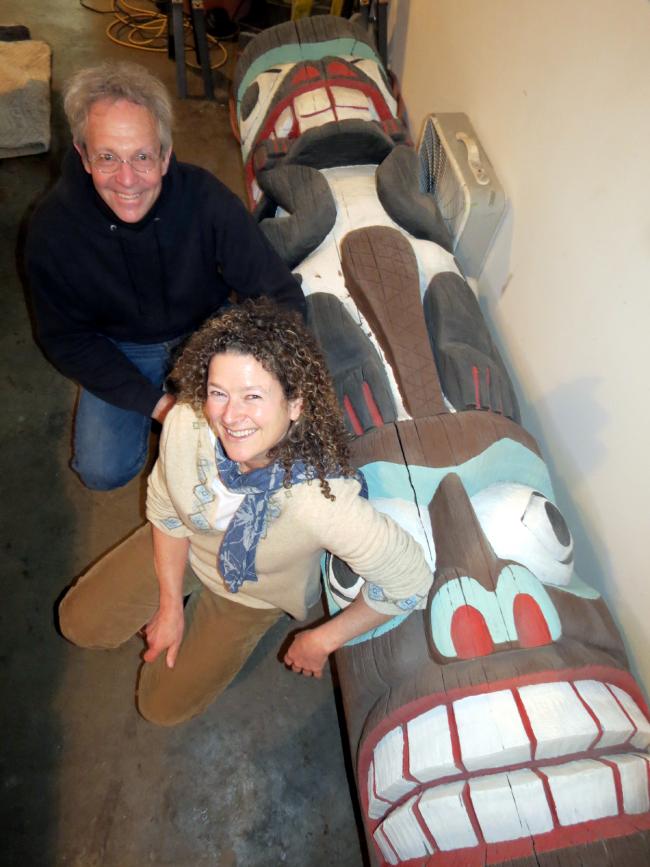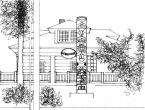Admiral totem pole to rise again
on June 6 at Log House Museum
Roger Waterhouse and Denise Bisio of Artech Fine Arts Services pose in March 2014 with the restored 1966 Admiral totem pole. It will rise again on June 6 in a community celebration at the Log House Museum.
Mon, 05/05/2014
information from the Southwest Seattle Historical Society
The colorful totem pole that welcomed residents and tourists alike at the city’s Belvedere View Point Park from 1966 to 2006 has been fully restored and soon will go on display at the Southwest Seattle Historical Society’s “Birthplace of Seattle” Log House Museum.
The public unveiling ceremony featuring public officials, the Duwamish tribe and the student bodies of both Alki and Schmitz Park elementary schools will take place at 10:30 a.m. Friday, June 6, 2014, outside the museum at 3003 61st Ave. S.W.
A portion of 61st Avenue Southwest east of the museum will be closed during the event to make room for the crowd. Overhead group photos and video will be taken and made available soon afterward.
“Given that it’s such a beloved icon and that it hasn’t been seen standing and in good shape for many years, we are expecting a big turnout,” says Clay Eals, executive director of the Southwest Seattle Historical Society, which operates the Log House Museum.
Eals encourages those planning to be present for the half-hour unveiling ceremony to arrive early. “We are particularly pleased that so many local elementary-age students will be attending,” he says. “This event will create memories to last a lifetime.”
Carved by Boeing engineers Michael Morgan and Bob Fleischman from a log harvested from Schmitz Park, the totem pole stood at Belvedere View Point Park from 1966 to 2006. It is a nearly exact replica of a totem pole carved by the Bella Bella tribe of British Columbia and brought to Belvedere View Point Park 75 years ago, in 1939, by West Seattleite and Ye Olde Curiosity Shop owner J.E. “Daddy” Standley.
Recognizing the deteriorated condition of the 1966 totem pole, Seattle Parks and Recreation removed it in 2006 and replaced it with a differently designed and unpainted story pole carved by a descendant of Chief Seattle.
The restored 1966 totem pole will stand next to the museum in its native-plant garden, facing east along the 61st Avenue Southwest arterial, just one block south of Alki Beach, where a party of white settlers landed on Nov. 13, 1851, and encountered the native Duwamish Tribe and the city of Seattle was founded.
“City parks gave us the 1966 totem pole on the understanding that we would restore it and raise it at our museum,” says Marcy Johnsen, board president of the Southwest Seattle Historical Society. “We are thrilled that after eight years of planning, fundraising and other work, the day is drawing near when it will stand tall again in West Seattle.”
To coincide with the unveiling of the 1966 totem pole, the historical society will launch a new mini-exhibit, “Reaching the Sky: Totem Tales of West Seattle,” inside the “Birthplace of Seattle” Log House Museum. The organization also is producing a traveling exhibit and brochure about the peninsula’s totem poles. These interpretive activities are generously funded by 4Culture.
For several years, the historical society has contracted and worked with Artech Fine Art Services of Seattle to restore the 1966 totem pole to its original and colorful glory. Major contributors to the restoration include Artech, the National Society of the Colonial Dames of America and Seattle City Council member Tom Rasmussen.
Dignitaries who will unveil the pole
The June 6 ceremony will draw nearly 20 special guests who will formally unveil the pole. So far, they include:
* Seattle Mayor Ed Murray, who grew up across the street from the museum.
* King County Executive and West Seattle native and resident Dow Constantine.
* Duwamish Tribal Chair Cecile Hansen, who will bless the pole on behalf of the tribe.
* Seattle City Council member and West Seattle resident Tom Rasmussen.
* King County Council member and West Seattle resident Joe McDermott.
* Greg Nickels, former Seattle mayor, the only West Seattle resident to serve as mayor.
* Former Seattle City Council member and former West Seattleite Phyllis Lamphere.
* Robert Stowers, South Parks Resources Manager, Seattle Parks and Recreation.
* Seattle Public Schools Superintendent Jose Banda.
* 4Culture Executive Director Jim Kelly.
* Dick Barnecut and Ken Lowthian, West Seattle civic leaders who helped organize the pole’s original dedication at Belvedere View Point Park on Aug. 10, 1966.
* Vicki Schmitz, representing the family that donated Schmitz Park to the city.
* Joe James, grandson of West Seattle resident J.E. “Daddy” Standley, first proprietor of Ye Olde Curiosity Shop.
* Susan Lynam, president of the National Society of the Colonial Dames of America in the State of Washington.
* Alki Elementary School Principal Shannon Stanton and a representative student.
* Schmitz Park Elementary School Principal Gerrit Kischner and a representative student.
History of the Admiral totem pole
The totem pole to be unveiled is the second of three totem poles that have graced Belvedere View Point Park, at the crest of Admiral Way in the north end of West Seattle, since 1939. The history of the three is both prominent and iconographic.
“When we make presentations to community groups, we often ask what served as Seattle's Space Needle before the Space Needle, and audiences respond almost instinctively,” Eals says. “The answer, of course, is the totem pole, and for 75 years the city’s most emblematic totem pole has stood at the Belvedere View Point Park.”
In its three incarnations, a totem pole has anchored this sliver of an auto turnout, serving as a sentinel over one of the most popular views of the downtown skyline. That a totem pole has framed this postcard panorama is fitting, given that West Seattle is the "Birthplace of Seattle," where white settlers arrived in 1851 and engaged with Native Americans who had made the Duwamish peninsula their home for thousands of years.
The first totem pole at Belvedere View Point Park was carved in 1901 by the Bella Bella tribe of British Columbia and brought to the viewpoint in 1939 by J.E. "Daddy" Standley, resident of the Admiral area of West Seattle and proprietor of the Ye Olde Curiosity Shop on the downtown waterfront.
After the first pole deteriorated, a second pole was carved as a replica of the first and installed at Belvedere View Point Park in 1966. Two Boeing engineers, Michael Morgan and Bob Fleischman, carved this pole on a voluntary basis, using a log harvested from the city’s old-growth Schmitz Park in West Seattle. The project enlisted many volunteers to complete the painting of the pole at Seattle’s Woodland Park Zoo before the pole was installed at Belvedere View Point Park.
Over the decades, the second pole suffered deterioration similar to that of the first, and 40 years after its installation, it was replaced in 2006 at Belvedere View Point Park by a third pole (more accurately called a story pole) carved by Michael Halady, a fifth-generation descendent of Chief Seattle. The third pole stands today at the viewpoint.
Seattle Parks and Recreation gave the second totem pole to the Southwest Seattle Historical Society based upon on the organization’s intention to restore and install it at its museum.
Interpretation of the totem pole
As a complement to the unveiling of the totem pole, the Southwest Seattle Historical Society is creating an exhibit program called “Reaching the Sky: Totem Tales of West Seattle.”
Easily seen from busy Admiral Way, brightly colored and often photographed as it stood at Belvedere View Point from 1966 to 2006, the pole is a fondly remembered icon by everyone living today who is connected to West Seattle from teen-age on up.
The story of this pole, including its creation by two Caucasians who aimed to honor the Native American tradition in the mid-1960s, will be part of a compelling narrative of relationships between cultures. It will be the basis of a mini-exhibit at the “Birthplace of Seattle” Log House Museum and a traveling exhibit to be shared at the Duwamish Longhouse and at schools, libraries and other community venues.
In addition to details on the 1966 pole, “Reaching the Sky: Totem Tales of West Seattle” also will provide background on the first and third poles at Belvedere View Point Park, as well as on a 1976 totem pole that is the focal point of Rotary Viewpoint Park in the Junction area of West Seattle.
The iconography of these poles, in their historical use in community settings and publications, also will be explored, as will their status as a uniquely Pacific Northwest phenomenon.
Community impact of the totem pole
The totem pole will become a beacon for the Log House Museum and easily its largest displayed artifact other than the 1904 museum building itself.
It will help draw the attention of thousands who have visited the museum and tens of thousands of new visitors, including those who frequent nearby Alki Beach every summer. These audiences will learn the story behind the pole and behind all totem poles in West Seattle.
Because the exhibits will tell the story of interaction between cultures, they will draw together all segments of West Seattle and the communities beyond, just as the 1966 totem pole itself did for 40 years at Belvedere View Point Park.





